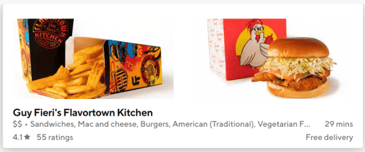2 min read
Why Online Ordering Is Now Essential for C-Stores
It’s not news to any c-store owner that competition for customers and spend is higher than ever. In addition to the many direct competitors in the...
Platform
What is Paytronix Guest Engagement Suite?
Combining online ordering, loyalty, omnichannel messaging, AI insights, and payments in one suite. Paytronix delivers relevant, personal experiences, at scale, that help improve your entire digital marketing funnel by creating amazing frictionless experiences.
A Complete Guest Engagement Suite
Online Ordering
Acquire new customers and capture valuable data with industry leading customization features.
Loyalty
Encourage more visits and higher spend with personalized promotions based on individual activity and preferences.
Catering
Grow your revenue, streamline operations, and expand your audience with a suite of catering tools.
CRM
Build great customer relationships with relevant personal omnichannel campaigns delivered at scale.
Artificial Intelligence
Leverage the most data from the most customer transactions to power 1:1 marketing campaigns and drive revenue.
Payments
Drive brand engagement by providing fast, frictionless guest payments.
Solutions
Paytronix Guest Engagement Solutions
We use data, customer experience expertise, and technology to solve everyday restaurant and convenience store challenges.
FlightPaths are structured Paytronix software onboarding journeys designed to simplify implementation and deliver maximum ROI.
Customer Success Plans (CSPs) are tiered service offerings designed to help you get the most from your Paytronix software, whether you prefer self-guided support or hands-on partnership.
Contactless Experiences
Accommodate your guests' changing preferences by providing safe, efficient service whether dining-in or taking out.
Customer Insights
Collect guest data and analyze behaviors to develop powerful targeted campaigns that produce amazing results.
Marketing Automation
Create and test campaigns across channels and segments to drive loyalty, incremental visits, and additional revenue.
Mobile Experiences
Provide convenient access to your brand, menus and loyalty program to drive retention with a branded or custom app.
Subscriptions
Create a frictionless, fun way to reward your most loyal customers for frequent visits and purchases while normalizing revenues.
Employee Dining
Attract and retain your employees with dollar value or percentage-based incentives and tiered benefits.
Order Experience Builder
Create powerful interactive, and appealing online menus that attract and acquire new customers simply and easily.
Loyalty Programs
High-impact customizable programs that increase spend, visit, and engagement with your brand.
Online Ordering
Maximize first-party digital sales with an exceptional guest experience.
Integrations
Launch your programs with more than 450 existing integrations.
Loyalty Programs
Deliver the same care you do in person with all your digital engagements.
Online Ordering
Drive more first-party orders and make it easy for your crew.
Loyalty Programs
Digital transformations start here - get to know your guests.
Online Ordering
Add a whole new sales channel to grow your business - digital ordering is in your future.
Integrations
We work with your environment - check it out
Tobacco Reporting
Comply with AGDC 2026 DTP Requirements
Company
We are here to help clients build their businesses by delivering amazing experiences for their guests.
Meet The Team
Our exceptional customer engagement innovations are delivered by a team of extraordinary people.
News/Press
A collection of press and media about our innovations, customers, and people.
Events
A schedule of upcoming tradeshows, conferences, and events that we will participate in.
Careers
Support
Paytronix Login
Order & Delivery Login
Resources
Paytronix Resources
Learn how to create great customer experiences with our free eBooks, webinars, articles, case studies, and customer interviews.
FlexPoint Service Catalog
Access FlexPoints are a cost-effective, flexible way to access our value-added services, to ensure you get greater impact from your Access software solution.
See Our Product In Action
E-Books
Learn more about topics important to the restaurant and c-store customer experience.
Reports
See how your brand stacks up against industry benchmarks, analysis, and research.
Blog
Catch up with our team of in-house experts for quick articles to help your business.
Case Studies
Learn how brands have used the Paytronix platform to increase revenue and engage with guests.
Unlock loyalty strategies that 3 out of 4 restaurants use to boost engagement by 40% without adding staff.
3 min read
Aug 25, 2021

Remaining competitive in the digital space means leveraging data to boost your business at every opportunity. You might be surprised to learn just how much actionable information is at your fingertips if you know how to mine the data available to you.
For the convenience store operator looking to stand out from the competition, data can answer some key questions: Who is your competition, and how can you overcome their strategies to own the customer?
I recently had the chance to address a wonderful crowd at the Outlook Leadership Conference about this very issue.
Calculating how to best compete begins with knowing who you are competing against. You can start by putting yourself in the place of the customer along the customer journey. A customer has a need and undertakes a search to fill it. The search can be a neighborhood walk, a driving search or, increasingly, an online search.
Not long ago I tried this myself. I looked on Yelp for fuel near me and found 10 locations – but a closer look revealed only four competitors since many carry the same flag. Similarly, a search for coffee brought up 86 locations. And a broader search for food gave me a whopping 130 locations within two miles – and when I switched over to Doordash and Grubhub another 36 locations showed up that weren’t on Yelp.
 But wait. Why do DoorDash and Grubhub have listings that aren’t on Yelp? Well, some of those are “ghost kitchens.” This is a term that’s cropped up a lot lately and one that is having a major impact on any company dealing with delivery. I discovered two brands I had never seen before Guy Fieri’s flavortown kitchen and Mr. Beast Burger. It turns out they are virtual brands where you can only buy their food through delivery services (no dine-in) and the food is prepared in the kitchen of a well-known Italian chain Bertucci’s.
But wait. Why do DoorDash and Grubhub have listings that aren’t on Yelp? Well, some of those are “ghost kitchens.” This is a term that’s cropped up a lot lately and one that is having a major impact on any company dealing with delivery. I discovered two brands I had never seen before Guy Fieri’s flavortown kitchen and Mr. Beast Burger. It turns out they are virtual brands where you can only buy their food through delivery services (no dine-in) and the food is prepared in the kitchen of a well-known Italian chain Bertucci’s.
Three types of Ghost Kitchens are currently flourishing: Virtual brands like Guy Fieri’s; restaurants that are growing into new regional markets and trying out new brands; and third-party aggregators themselves, like DoorDash and Uber Eats. This means you have actually been battling for customers against competitors you couldn’t even see unless you went looking in your phone. That kind of competition calls for a significant digital strategy on your part.
How can any brand compete on the delivery marketplaces when there are 166 listings within a 2 mile radius? What will it take to get to the top of search listings? It seems some brands are stacking the deck with ghost kitchens so they show up if you search for “Italian,” or “chicken” or “burgers.” This seems like a daunting task for any brand. What makes more sense is to change the rules to a game that is easier to understand, control and measure; you should own the customer.
Now you know who you are competing with – and everyone is in a fight to own the customer. Fortunately, the data behind the most successful brands tells us their secrets.
Today’s marketplace is a double-edged sword – the pressure on businesses to compete with data and tech is higher than ever, but emerging tools are giving you the means to do so.
Do you have questions about how you can better leverage data to benefit your business? Our team can help. Book a demo today.

2 min read
It’s not news to any c-store owner that competition for customers and spend is higher than ever. In addition to the many direct competitors in the...

3 min read
The competition is fierce for guests’ online business, and restaurants and c-stores are working to keep their brands competitive and stay on top of...

12 min read
Since its initial surge during the pandemic, online ordering is both a significant revenue driver for restaurants and key restaurant trend, as well...